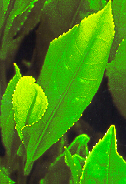HOME PAGE

CAKE & SNACK
Kastella

Dorayaki

Kompeitoh

DRESSING

GARDENING

GREEN TEA
Varieties

Preparation

When
and where

Benefits

PICKLES
Beer-zuke

Hakumai-zuke

Bettara-zuke

NATTO

SUSHI
Rice

Nigiri-zushi

Hako-zushi

Temaki-zushi

Masu-zushi

(Links are given for convenience of the readers.
We by no means promote
or endose the companies or
organization of the links given on this page.)

 Astounding facts of tea benefits have been
revealed in recent years, which show overwhelming superiority of
green tea over other kinds of drinks.
Astounding facts of tea benefits have been
revealed in recent years, which show overwhelming superiority of
green tea over other kinds of drinks. Surveys demonstrate that, (1) the cancer rate of Japanese population is remarkably lower than other countries, (2) the cancer rate in the Shizuoka prefecture, where tea is produced, is the lowest among all other prefectures in Japan, and (3) even in the same prefecture, the cancer rate among the tea farmers is the lowest.
Green tea has been shown to prevent the activation of carcinogens so that free radicals never form in the first place. A Japanese research shows that several cups of green tea per day reduce lung cancer rates among men who smoke. Rutgers studies showed that green tea protects against sun damage and, by extension, skin cancer.
The benefits of green tea may be summarized as follows:
- Catechins, bitter component of green tea, effectively kills almost every bacteria, including e-coli bacteria, which causes food poisoning.
- Green tea contains a high amount of fluoride, which may help strengthen teeth and bones and reduce tooth decay.
- Catechins and bioflavonoids in green tea may contribute to its potential to fight skin, esophageal, stomach and colon cancers. A powerful antioxidant ingredient in green tea kills human cancer cells in laboratory experiments (Journal of the National Cancer Institute for December 17, 1997). Antioxidants block cancer by preventing damage to cell DNA. One of these, EGCG, recently tested 100 times stronger than vitamin C and 25 times stronger than vitamin E at protecting DNA.
- Green tea may be used externally to stop or slow bleeding from cuts and scrapes and to relieve itchy insect bites. Research is also being done to find out if it may be used as a natural sun block. It may also regulate blood sugar and insulin levels.
- Catechin and polysaccharides in green tea can lower blood sugar of human. This effect has been confirmed with mice experiments.
- Increases vitality of human body.
- Green tea slows down human aging process.
- Green tea prevents food poisoning.
- Green tea preserves freshness of other foods.
- Green tea may be used as deordant.
More Details from the Reports of Benefits:
By 1987, Hirota Fujiki, a chemist at Japan's
National Cancer Center Research institute,
found a likely candidate in an antioxidant, known as
(-)-epigallocatechin gallate or EGCG. Some antioxidants are known
to prefect against tumor development by destroying the highly reactive
free radicals, atoms or molecules that disrupt normal cell processes
and confound the proper operation of DNA.
http://www.gi.alaska.edu/ScienceForum/ASF10/1064.html
EGCG is a member of the family of chemicals known as polyphenols,
antioxidant compounds which are found in green tea. EGCG and other
green tea polyphenols work as antioxidants in the body. Antioxidants
are compounds that attack the body's free radicals, which cause
cellular damage including DNA (genetic material) breakage.
http://www.techmall.com/techdocs/TS970911-14.html
The naturally occurring chemical compounds in tea, called 'polyphenols,'
are powerful antioxidants. The primary polyphenols found in tea are called
'catechins' which account for 30 to 40 percent of dry tea weight. Other
polyphenols found in tea include flavanols, flavanol glycosides,
flavandiols, phenolic acids, and depsides. Polyphenols act as 'bodyguards',
preventing damage caused by free radicals (damaging forms of oxygen) by
combining chemically with the free radicals. Polyphenols give tea its
characteristic astringent flavor. In the past, these polyphenols have
been mistakenly called 'tannins.' Polyphenols are chemically similar to
tannins, however tannins are not present in tea.
http://www.stashtea.com/greentea.htm
Green tea has been shown to significantly reduce the effects of carcinogens
in laboratory mice. It slowed the development of skin cancer in mice exposed
to UV radiation. It helped slow or prevent the formation of stomach and lung
cancer tumors (in mice). And, in one study, using one of the most potent
carcinogens in cigarette smoke, mice given this type of tea developed 45% fewer
lung cancer tumors.
In Japan, where they consume a lot of this beverage, the death rate from lung
cancer is much lower than here in the United States, even though the average
cigarette consumption among men in Japan is much higher.
Scientists currently believe that the active ingredient that may be responsible
for the anti carcinogenic effects are the group of polyphenols called catechins.
Dry black tea, like your ordinary grocery tea, contains 3%-10% catechins.
A full 30-42% of the dry weight of green tea consists of catechins.
http://www.qi-journal.com/Articles/tea.html
Green tea controls high blood pressure High blood pressure places a serious
burden on the vascular system and contributes to atherosclerosis.
http://www.daisan.co.jp/health4.htm
The inverse association between consumption of green tea and various serum
markers shows that green tea may act protectively against cardiovascular
disease and disorders of the liver.
http://www.thriveonline.com/health/Library/CAD/abstract9642.html
"We found
that this particular compound, which is present in the amount of about 200 mg
in one cup of green tea, can kill a variety of cancer cells through apoptosis
without affecting the normal cells," said Hasan Mukhtar, a professor of
dermatology at CWRU and senior author of the paper. The polyphenol broke
the DNA of the cancer cells into fragments, a characteristic of apoptosis.
"The killing of cancer cells and the sparing of normal cells is very
interesting because apoptosis is a programmed cell death which is a
normal process going on in the body all the time. It is a preferential
way of elimination of unwanted cells from the body," said Mukhtar.
http://www.cwru.edu/pubaff/univcomm/greentea.htm
About 60 years ago, Dr. Minowada of Kyoto University noticed that sugar in
the urine of patients hospitalized for diabetes fell markedly during
periods when they participated in chanoyu (Tea Ceremony). He reported that
powdered tea of the type used in the traditional Tea Ceremony had the
capability of lowering blood sugar. Diabetes is a disease characterized
by insufficient secretion or improper functioning of insulin, which
hinders the proper absorption of glucose into the tissues and leads to
a high concentration of blood sugar that must eventually be excreted into the
urine. If this high concentration of blood sugar should continue for a long
period, it will affect the vascular system and cause a number of quite serious
diseases including atherosclerosis and retinal hemorrhages. Dr. Hara(#10) gave
dried green tea catechin in edible form to mice that were subject to hereditary
diabetes and verified a lowering of their blood sugar. In parallel experiments,
Dr. Shimizu(#11) gave an extract of green tea to mice and demonstrated that it
had the ability to lower blood sugar (Table 4). It has also been shown that the
polysaccharides in green tea possess the same ability. Although these results
come from animal tests, the evidence that green tea catechin and polysaccharides
can lower blood sugar In mice may also, in light of Dr. Minowada's old report,
apply to humans.
http://www.daisan.co.jp/health5.htm
Additional references
- Good summary by Alexis Quinlan on internet web:
http://www.electra.com/awisd010.html - Books
- Oppliger P. Green Tea; The Delicious Everyday Health Drink. CW Daniel Company Limited USA/Canada, 1998
- Ode, P. The Complete Medicinal Herbal, Dorling Kindersley, New York, 1993
- Grieve, M., A modern Herbal, Dover Publications, 1971
- Balch, J. F. and P. A., Prescription for Nutritional Healing, Avery Publishing Group, New York, second ed.